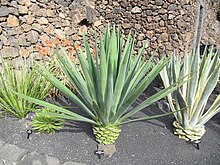Henequen
| Henequen | |
|---|---|
 |
|
| Scientific classification | |
| Kingdom: | Plantae |
| Clade: | Angiosperms |
| Clade: | Monocots |
| Order: | Asparagales |
| Family: | Asparagaceae |
| Subfamily: | Agavoideae |
| Genus: | Agave |
| Species: | A. fourcroydes |
| Binomial name | |
|
Agave fourcroydes Lem. |
|
Henequen (Agave fourcroydes Lem.) is an agave, a plant species native to southern Mexico and Guatemala. It is reportedly naturalized in Italy, the Canary Islands, Costa Rica, Cuba, Hispaniola, the Cayman Islands and the Lesser Antilles.
The leaves of Agave fourcroydes yield a fiber also called henequen, which is suitable for rope and twine but not of as high a quality as sisal. Alternative spellings are Henequin and Heniquen. It is the major plantation fiber agave of eastern Mexico, being grown extensively in Yucatán, Veracruz, and southern Tamaulipas. It is also used to make licor del henequén, a traditional Mexican alcoholic drink.
The plant appears as a rosette of sword-shaped leaves 1.2 to 1.8 meters long, growing out of a thick stem that may reach 1.7 meters (5 ft). The leaves have regularly spaced teeth 3–6 mm long and a terminal spine 2–3 cm long.
Like sisal, A. fourcroydes is a sterile hybrid; the ovaries never produce seeds. The plant does produce bulbils that may be planted, but commercial growers prefer to use the frequent suckers, which develop more quickly.
The first person of Spanish descent to document the plant and its usefulness for ropes and other naval utensils was José María Lanz, a Mexican-born engineer in service of the Spanish Navy, who studied henequen in Yucatán in 1783.
Henequen farm in Yucatán Peninsula.
...
Wikipedia
